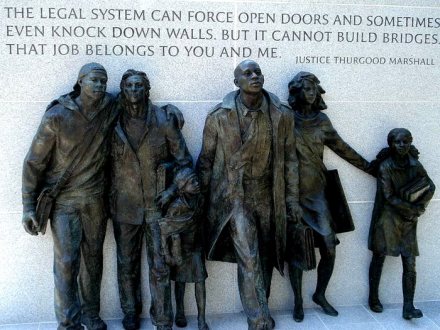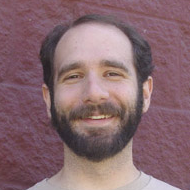 As Americans, we’re rightly proud to consider our nation a melting pot, bringing different groups together across national, ethnic, racial, religious, and ideological backgrounds to create an alloy, a unified whole that is stronger and greater than its constituent parts. As Crevècoeur wrote in the nation’s infancy, “What, then, is the American, this new man? He is neither a European nor the descendant of a European; hence that strange mixture of blood, which you will find in no other country...he is an American, who, leaving behind him all his ancient prejudices and manners, receives new ones from the new mode of life he has embraced, the new government he obeys, and the new rank he holds.”
As Americans, we’re rightly proud to consider our nation a melting pot, bringing different groups together across national, ethnic, racial, religious, and ideological backgrounds to create an alloy, a unified whole that is stronger and greater than its constituent parts. As Crevècoeur wrote in the nation’s infancy, “What, then, is the American, this new man? He is neither a European nor the descendant of a European; hence that strange mixture of blood, which you will find in no other country...he is an American, who, leaving behind him all his ancient prejudices and manners, receives new ones from the new mode of life he has embraced, the new government he obeys, and the new rank he holds.”
Our public schools play a crucial role in fostering that civic unity. As Chief Justice Warren wrote for the Supreme Court in Brown v. Board of Education:
Today, education is perhaps the most important function of state and local governments. Compulsory school attendance laws and the great expenditures for education both demonstrate our recognition of the importance of education to our democratic society. It is required in the performance of our most basic public responsibilities, even service in the armed forces. It is the very foundation of good citizenship. Today it is a principal instrument in awakening the child to cultural values, in preparing him for later professional training, and in helping him to adjust normally to his environment. In these days, it is doubtful that any child may reasonably be expected to succeed in life if he is denied the opportunity of an education. Such an opportunity, where the state has undertaken to provide it, is a right which must be made available to all on equal terms.
Not everyone agrees, though. The Cato Institute, a glibertarian advocacy group and prominent fount of climate change denial, has posted what purports to be a “public schooling battle map,” cataloging disputes over the content and administration of public classrooms, and claiming, “Rather than bringing diverse people together public schooling divides them, forcing them into conflict over whose values and histories will be taught, and whose basic rights will be upheld…or trampled.”
The map covers a fairly random assemblage of conflicts over schools, categorized as fights over “curriculum,” “freedom of expression,” “gender equity,” “human origins,” “moral values,” etc. The list of conflicts over “human origins” includes a proposed initiative in Nevada that didn’t even make the ballot because it got too few signatures, the perennial conflicts in the Kansas state board of education, and the North Dakota High School Activities Association’s decision not to use “intelligent design” as a debate topic. It doesn’t include the Dover trial or a host of other prominent battles over evolution in schools. I don’t see any coverage of climate change, which is probably for the best. The map is thus not terribly useful as a survey of what’s actually happening in schools.
As an argument against the value of public education, it is even less useful. At its core, the claim seems to be that public schools are supposed (in part) to stop discord, and people disagree about public schools, so public schools should be done away with. This is not even a plausible logical chain; we would hardly say “firefighters are meant to stop house fires, but houses still burn down, so let’s get rid of the firefighters.”
Actually, in light of the latest shutdown of the federal government and the possibility that the same Tea Party intransigence could have forced the nation to default on its debts, we might more appropriately make the analogy: representative democracy is supposed to solve problems, our elected Congress can’t agree on how to solve problems, so let’s abandon democratic government. But, of course, the point of holding elections is not to end disagreements, but to provide a venue in which advocates can make their best case, voters in their collective wisdom can make a choice, and the winners get to move ahead.
Similarly, a prime aim of public education is not so much to eliminate conflict as to teach people how to disagree constructively. The goal is to bring diverse people together, to show a student that someone can disagree with him and not be evil, and to teach a student how to marshal the evidence and arguments to bolster her own view, and how to change her mind if someone else makes a good point. That doesn’t mean that the disagreement disappears, but it means that we all learn to deal with disagreement respectfully. As game theorists know, repeated interactions (as in the iterated prisoner’s dilemma) create an incentive to cooperate, even when one’s personal interest might lie elsewhere.
In recent years, the different elements of melting-pot America have started to separate. As Bill Bishop and Bob Cushing point out in The Big Sort, we’re getting better and better at moving to communities where everyone thinks like us, looks like us, shops like us, and votes like us. Much of the conflict we’re seeing in Congress today can be traced to that Big Sort, since members of Congress are beholden to increasingly homogeneous home districts, creating a more ideologically extreme Congress. (Especially, according to the best political science, on the Republican side. See http://grist.org/politics/asymmetrical-polarization-the-lefts-gone-left-but-the-rights-gone-nuts/). That ideological purity leaves no incentive for compromise, or for revisiting decisions in light of new evidence. The same thing happens with locally elected school boards, the 17,000 democracies which make most of the critical curriculum decisions, and which have also grown increasingly homogeneous.
Cato’s solution is to take this process even further. Instead of one school system, they envision dozens of different private schools, each pursuing its own ideological agenda, each telling its students that they are right and everyone else is wrong. This would favor popular views, but wouldn’t serve the students well. Not only would it deprive students of a chance to explore the diversity of their society and the world, but it could well cut them off from an accurate and objective understanding of the world.
Science, after all, is not a democracy. The same goes for math, history, and literature. The validity of evolution, calculus, the Union’s victory in the Civil War, or an interpretation of Shakespeare is not changed based on how many voters agree.  Cato’s dream would lead to a system of separate schools, notionally equal, but each covering topics according to the whims of the sectarian interests of its backers. Schools connected to a community’s majority, and to its most powerful subgroups, will be better, while minority groups and the poor would be cut out.
Cato’s dream would lead to a system of separate schools, notionally equal, but each covering topics according to the whims of the sectarian interests of its backers. Schools connected to a community’s majority, and to its most powerful subgroups, will be better, while minority groups and the poor would be cut out.
As a wise man once wrote, “in the field of public education the doctrine of ‘separate but equal’ has no place. Separate educational facilities are inherently unequal.”
Images via WikiCommons (public domain) and Discover Black Heritage's page on the Virginia Civil Rights Memorial.

